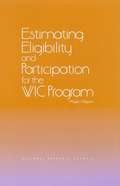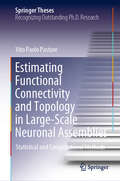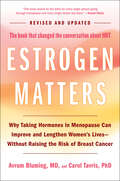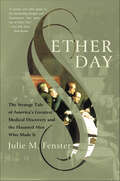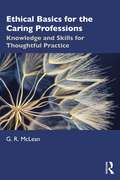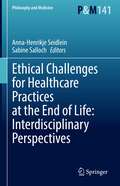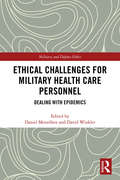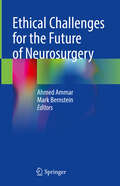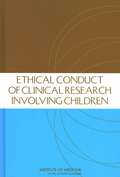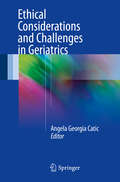- Table View
- List View
Estimating Eligibility and Participation for the WIC Program: Phase I Report
by Panel to Evaluate the USDA's Methodology for Estimating Eligibility Participation for the WIC ProgramA report on Estimating Eligibility and Participation for the WIC Program
Estimating Functional Connectivity and Topology in Large-Scale Neuronal Assemblies: Statistical and Computational Methods (Springer Theses)
by Vito Paolo PastoreThis book describes a set of novel statistical algorithms designed to infer functional connectivity of large-scale neural assemblies. The algorithms are developed with the aim of maximizing computational accuracy and efficiency, while faithfully reconstructing both the inhibitory and excitatory functional links. The book reports on statistical methods to compute the most significant functional connectivity graph, and shows how to use graph theory to extract the topological features of the computed network. A particular feature is that the methods used and extended at the purpose of this work are reported in a fairly completed, yet concise manner, together with the necessary mathematical fundamentals and explanations to understand their application. Furthermore, all these methods have been embedded in the user-friendly open source software named SpiCoDyn, which is also introduced here. All in all, this book provides researchers and graduate students in bioengineering, neurophysiology and computer science, with a set of simplified and reduced models for studying functional connectivity in in silico biological neuronal networks, thus overcoming the complexity of brain circuits.
Estimating Mortality Risk Reduction And Economic Benefits From Controlling Ozone Air Pollution
by National Research Council of the National AcademiesIn light of recent evidence on the relationship of ozone to mortality and questions about its implications for benefit analysis, the Environmental Protection Agency asked the National Research Council to establish a committee of experts to evaluate independently the contributions of recent epidemiologic studies to understanding the size of the ozone-mortality effect in the context of benefit analysis. The committee was also asked to assess methods for estimating how much a reduction in short-term exposure to ozone would reduce premature deaths, to assess methods for estimating associated increases in life expectancy, and to assess methods for estimating the monetary value of the reduced risk of premature death and increased life expectancy in the context of health-benefits analysis. Estimating Mortality Risk Reduction and Economic Benefits from Controlling Ozone Air Pollution details the committee’s findings and posits several recommendations to address these issues.
Estimating The Public Health Benefits Of Proposed Air Pollution Regulations
by Committee on Estimating the Health-Risk-Reduction Benefits of Proposed Air Pollution RegulationsThis volume contains the findings of a study the National Academy of Sciences carried out at the request of the Environmental Protection Agency to assess the health-risk-reduction benefits that would result from proposed air pollution regulations. The committee in charge of the study was made up of specialists in medicine, public health, economics, environmental science, risk assessment, epidemiology, biostatistics, and human toxicology in the US, Switzerland, and the UK. Once the methodology has been outlined the main topics are exposure and response, degree of uncertainty in EPA risk analysis, and use of health benefits analysis. Not indexed. Annotation c. Book News, Inc. , Portland, OR (booknews. com)
Estimation of the Time Since Death
by Burkhard MadeaEstimation of the Time Since Death remains the foremost authoritative book on scientifically calculating the estimated time of death postmortem. Building on the success of previous editions which covered both the early and later postmortem periods this edition includes a new chapter on DNA/RNA degradation and further new content on drug testing in hair, thus widening the scope of the material. Chapters have been improved, updated and expanded, and include new and additional images to enhance the text. A unique work of synthesis combining rigorous science with practical guidance, this update reinforces the book’s reputation as an invaluable resource – and also the standard – for the estimation of the time since death.
Estrogen Matters: Why Taking Hormones in Menopause Can Improve Women's Well-Being and Lengthen Their Lives -- Without Raising the Risk of Breast Cancer
by Carol Tavris Avrum BlumingA compelling, &“fascinating&” (Robert Cialdini) defense of hormone replacement therapy, exposing the faulty science behind its fall from prominence and giving women the evidence they need to make informed decisions about their health. Now fully revised and updated."Estrogen Matters was my antidote to the misinformation surrounding menopause. This book should be the bible for every single person going through menopause.&”―Naomi Watts For years, hormone replacement therapy (HRT) was the medically approved way to alleviate menopausal symptoms (ranging from hot flushes to brain fog) and reduce the risk of heart disease, Alzheimer's, and osteoporosis. But when a large study by the Women's Health Initiative (WHI) announced, with national fanfare, that women taking HRT had an increased risk of breast cancer, women were scared off, and the treatment was abandoned. Now, Dr. Bluming, a medical oncologist, and Dr. Tavris, a social psychologist, reveal the true story of the WHI&’s efforts to distort their data to exaggerate unsupported claims of estrogen&’s harms. Important updates in this edition include: Evidence that demolishes the WHI&’s claim that HRT causes breast cancer. A list of the WHI&’s retractions of their original scare stories. Updated findings on estrogen&’s benefits on heart, brain, bones, and longevity. A critical review of the alternative products and medications being marketed to treat symptoms of menopause. A sobering and revelatory read, Estrogen Matters sets the record straight on estrogen&’s benefits, providing a light to guide women through this inevitable phase of life.
Estrogen Receptor and Breast Cancer: Celebrating the 60th Anniversary of the Discovery of ER (Cancer Drug Discovery and Development)
by Xiaoting ZhangThe discovery of ER by Dr. Elwood Jensen exactly 60 years ago has not only led to the birth of a whole new vital nuclear receptor research field but also made a rapid, direct and lasting impact on the treatment and prevention of breast cancer. Since that landmark discovery, tremendous progress has been made in our understanding of the molecular functions of ER and development of targeted therapies against ER pathways for breast cancer treatment. However, there is currently no book available addressing these discoveries and recent advancement in a historical and systematic fashion. This book is intended to provide comprehensive, most up-to-date information on the history and recent advancement of ER and breast cancer by world renowned leaders in the field. These chapters include the history of the discovery of ER; physiological and pathological roles of ER; recent discovery of ER cistrome, transcriptome and its regulation of noncoding RNAs such as microRNAs and enhancer RNAs in breast cancer; development and clinical practices of the first targeted therapy Tamoxifen and other antiestrogens for breast cancer treatment; structural basis of ER and antiestrogen actions; molecular insights into endocrine resistance; the role of ER mutants, ER-beta and environmental estrogens in breast cancer; and emerging state-of-the-art therapeutic approaches currently in development to overcome treatment resistance and future perspectives. The book will provide undergraduate and graduate students, basic scientists and clinical cancer researchers, residents, fellows, as well as clinicians, oncology educators and the general public a thorough and authoritative review of these exciting topics.
Estrogen Receptors: Methods And Protocols (Methods In Molecular Biology #1366)
by Kathleen M. EysterThis volume examines a wide array of vital technologies for advancing our understanding of the receptor-mediated actions of estrogen. The protocols in this book range from standard methods and vital laboratory workhorses, such as receptor binding assays and western blot, to newer technologies such as RNAseq and proximity ligation assay. Chapters also discuss protocols from a broad range of tissue types to demonstrate the variety of estrogen receptor effects. Written in the highly successful Methods in Molecular Biology series format, chapters include introductions to their respective topics, lists of the necessary materials and reagents, step-by-step, readily reproducible laboratory protocols, and tips on troubleshooting and avoiding known pitfalls. Cutting-edge and thorough, Estrogen Receptors: Methods and Protocols is a detailed and helpful resource for scientists who are intrigued by the many facets of estrogen.
Estrés: Un asesino sigiloso moderno (¿Cómo...? #37)
by Owen JonesEstrés – Un asesino sigiloso moderno es una guía introductoria para el entendimiento y manejo del estrés en el mundo acelerado de hoy. El libro adopta un enfoque holístico para el manejo del estrés, analizando las causas, los síntomas y los efectos de este, así como estrategias practicas para reducir el estrés y mejorar el bienestar general. A través de este libro, el lector aprenderá sobre diferentes tipos de estrés, como el estrés agudo, el estrés crónico y el estrés traumático; y como cada uno afecta al cuerpo y la mente de manera diferente. El autor también profundiza en los cambios fisiológicos que ocurren en el cuerpo cuando está bajo estrés y como estos cambios pueden conducir a problemas de salud graves, como cardiopatías, diabetes y problemas de salud mental como depresión y ansiedad. El libro también ofrece una variedad de técnicas prácticas para reducir el estrés, como la atención plena y la meditación, el ejercicio y la gestión del tiempo, y cómo incorporar estas técnicas en la vida diaria. También cubre cómo establecer límites personales e identificar y evitar factores estresantes que están fuera de nuestro control. Uno de los aspectos más completos es que también cubre algunos conceptos erróneos comunes sobre el estrés y su manejo y cómo distinguir el estrés bueno del estrés malo y equilibrar el estrés bueno con un nivel manejable de estrés malo. En general, “Estrés, un asesino sigiloso moderno” es un recurso introductorio esencial para cualquier persona que busque comprender y manejar mejor el estrés en sus vidas. Está escrito en un lenguaje fácil de entender, lo que lo hace accesible a lectores de todos los orígenes y niveles de conocimiento. El libro es una lectura obligada para cualquier persona interesada en mejorar su salud física y mental, y lograr una mayor sensación de bienestar. Espero que encuentre la información de ayuda, útil y provechosa.<br
Estuaries of Australia in 2050 and beyond
by Eric WolanskiThe book addresses the questions: Is Australia's rapidly growing human population and economy environmentally sustainable for its estuaries and coasts? What is needed to enable sustainable development? To answer these questions, this book reports detailed studies of 20 iconic Australian estuaries and bays by leading Australian estuarine scientists. That knowledge is synthesised in time and space across Australia to suggest what Australian estuaries will look like in 2050 and beyond based on socio-economic decisions that are made now, and changes that are needed to ensure sustainability. The book also has a Prologue by Mr Malcolm Fraser, former Prime Minister of Australia, which bridges environmental science, population policy and sustainability.
Eten en drinken bij dementie (Nursing-Dementiereeks)
by Jeroen Wapenaar Lisette De GrootDit boek geeft verzorgenden, verpleegkundigen en voedingsassistenten alle benodigde kennis over eten en drinken bij dementie. Het uitgangspunt is dat een positieve en persoonlijke benadering het beste werkt. Je krijgt praktische handvatten om je cliënten goed te kunnen ondersteunen. Je leert hoe je kunt helpen bij het eten en drinken, zodat cliënten zo gezond mogelijk blijven - en hun kwaliteit van leven daardoor verbetert. Verzorgenden en verpleegkundigen kunnen met de juiste kennis en voldoende aandacht een cruciale rol spelen. In deze geheel herziene druk van Eten en drinken bij dementie zijn de meest actuele adviezen van het Voedingscentrum opgenomen, net als belangrijke richtlijnen en nieuwe lessen uit onderzoek en praktijk. Nieuw is ook het overzicht van handvatten over eten en drinken bij dementie dat je kunt downloaden. Jeroen Wapenaar werkt als zelfstandig wetenschapsjournalist. Ouderenzorg is een van zijn specialisaties.Prof. dr. ir. Lisette de Groot is persoonlijk hoogleraar Voeding en gezondheid aan Wageningen University. In haar onderwijs en onderzoek richt ze zich op de vraag hoe voeding bij ouderen kan bijdragen aan het handhaven van de gezondheid.
Ethanol and the Liver: Mechanisms and Management
by David Sherman Ronald Ross WatsonDistilling the available knowledge on ethanol-induced liver damage and directly complementing the available bio-medical literature, Ethanol and the Liver covers pathogenic and clinical aspects of alcoholic liver disease. Providing broader coverage of the subject than any available monograph, the editors and their panel of experts relate basic scien
Ethel Gordon Fenwick: Nursing Reformer and the First Registered Nurse (Trailblazing Women)
by Jenny MainA great nursing reformer, Ethel Gordon Fenwick was born before the age of the motor car and died at the start of the jet age. When she began her career, nursing was a vocation, unregulated with a dangerous variety of standards and inefficiencies. A gifted nurse, Ethel worked alongside great medical men of the day and, aged 24, she became the youngest matron of St Bartholomew’s hospital London, where she instigated many improvements. At that time, anyone could be called a nurse, regardless of ability. Ethel recognized that for the safety of patients, and of nurses, there must be an accepted standard of training, with proof of qualification provided by a professional register. Often contentious, Ethel was a determined woman. She fought for nearly thirty years to achieve a register to ensure nurses were qualified, respected professionals. A suffragist and journalist, she travelled to America where she met like-minded nursing colleagues. As well as helping to create the International Council of Nurses, and the Royal British Nurses Association, she was also instrumental in organising nurses and supplies during the Graeco-Turkish War, and was awarded several medals for this work. Thanks to her long campaign for registration, a year after her death nurses were ready to take their place alongside other professionals when the National Health Service began in 1948.
Ether Day: The Strange Tale of America's Greatest Medical Discovery and the Haunted Men Who Made It
by Julie M. FensterA fascinating and entertaining look at the men behind the first surgical use of anesthesia—and the price they paid for their breakthrough.On Friday, October 16, 1846, only one operation was scheduled at Massachusetts General Hospital....That day in Boston, the operation was the routine removal of a growth from a man's neck. But one thing would not be routine: instead of using pulleys, hooks, and belts to subdue a patient writhing in pain, this crucial operation would be the first performed under a general anesthetic. No one knew whether the secret concoction would work. Some even feared it might kill the patient.This engrossing book chronicles what happened that day and during its dramatic aftermath. In a vivid history that is stranger than fiction, Ether Day tells the story of the three men who converged to invent the first anesthesia—and the war of ego and greed that soon sent all three men spiraling wildly out of control.
Ether Day: The Strange Tale of America's Greatest Medical Discovery and the Haunted Men Who Made it
by Julie M. FensterEther Day is the unpredictable story of America's first major scientific discovery -- the use of anesthesia -- told in an absorbing narrative that traces the dawn of modern surgery through the lives of three extraordinary men. Ironically, the "discovery" was really no discovery at all: Ether and nitrous oxide had been known for more than forty years to cause insensitivity to pain, yet, with names like "laughing gas, " they were used almost solely for entertainment. Meanwhile, patients still underwent operations during which they saw, heard, and felt every cut the surgeon made. The image of a grim and grisly operating room, like the one in Mary Shelley's Frankenstein, was in fact starkly accurate in portraying the conditions of surgery before anesthesia. With hope for relief seemingly long gone, the breakthrough finally came about by means of a combination of coincidence and character, as a cunning Boston dentist crossed paths with an inventive colleague from Hartford and a brilliant Harvard-trained physician. William Morton, Horace Wells, and Charles Jackson: a con man, a dreamer, and an intellectual. Though Wells was crushed by derision when he tried to introduce anesthetics, Morton prevailed, with help from Jackson. The result was Ether Day, October 16, 1846, celebrated around the world. By that point, though, no honor was enough. Ether Day was not only the dawn of modern surgery, but the beginning of commercialized medicine as well, as Morton patented the
Ethical Approaches to Human Remains: A Global Challenge in Bioarchaeology and Forensic Anthropology
by Nicholas Márquez-Grant Kirsty Squires David ErricksonThis book is the first of its kind, combining international perspectives on the current ethical considerations and challenges facing bioarchaeologists in the recovery, analysis, curation, and display of human remains. It explores how museum curators, commercial practitioners, forensic anthropologists, and bioarchaeologists deal with ethical issues pertaining to human remains in traditional and digital settings around the world. The book not only raises key ethical questions concerning the study, display, and curation of skeletal remains that bioarchaeologists must face and overcome in different countries, but also explores how this global community can work together to increase awareness of similar and, indeed, disparate ethical considerations around the world and how they can be addressed in working practices. The key aspects addressed include ethics in bioarchaeology and forensic anthropology, the excavation, curation, and display of human remains, repatriation, and new imaging techniques. As such, the book offers an ideal guide for students and practitioners in the fields of bioarchaeology, osteoarchaeology, forensic anthropology, medical anthropology, archaeology, anatomy, museum and archive studies, and philosophy, detailing how some ethical dilemmas have been addressed and which future dilemmas need to be considered.
Ethical Basics for the Caring Professions: Knowledge and Skills for Thoughtful Practice
by G. R. McLeanThis book trains students of the caring professions, across health and social care, in the basic philosophical skills and knowledge needed to deal with the ethical aspects of their profession. It shows why ethical education is required, and teaches the skills of reasoning that equip professionals to think critically about the theories and arguments used in ethical discussions. It demonstrates how we can be confident that we can rely on common moral ground; but it also points out how we need to recognise the influence of different world-views, and to note how, on some issues, these can lead us in starkly different directions. It explains relevant philosophical theories, and evaluates their strengths and weaknesses – particularly in relation to what is required for proper professional ethics. It shows how to employ the commonly accepted framework of four ethical principles – beneficence, non-maleficence, autonomy, and justice. These various matters are then illustrated in two extended case studies, which focus on the problem of euthanasia, and the question of screening for disability and the value of human life. Ethical Basics for the Caring Professions is designed for use on all health and social care and human services courses on ethics and values. It will also be of interest to academics and professionals working within these fields.
Ethical Challenges for Healthcare Practices at the End of Life: Interdisciplinary Perspectives (Philosophy and Medicine #141)
by Sabine Salloch Anna-Henrikje SeidleinThis book presents a collection of exclusively selected manuscripts on current ethical controversies related to professional practices from an interprofessional perspective. Insights are provided into the diversity of practices and viewpoints from different countries are merged in a unique way. The book contributes to the debate on social and legal issues regarding end-of-life practices such as organ donation, medically assisted dying and advance care planning. In addition, joint international author groups contributed exclusive chapters about European comparisons on end-of-life topics. The focus on country- and culture-specific aspects broadens the view on key issues and makes the book attractive for an international readership. The variety of approaches and methods used informs and inspires the development of new research and best-practice projects.
Ethical Challenges for Military Health Care Personnel: Dealing with Epidemics (Military and Defence Ethics)
by Daniel Messelken David WinklerThis book examines the issue of ethics in the context of the provision of military health care in an epidemic. Outbreaks of epidemics like Ebola trigger difficult ethical challenges for civilian and military health care personnel. This book offers theoretical reflections combined with reports from recent military and NGO missions in the field. The authors of this volume focus on military medical ethics adding a distinct voice to the topic of epidemics and infectious diseases. While military health care personnel are always crucially involved during disaster relief operations and large-scale public health emergencies, most of the current literature treats ethical issues during epidemics from a more general perspective without taking into account the specifics of the military context. The contributions in this volume provide first-hand insights into some of the ethical issues encountered by military health care personnel in missions during the Ebola outbreak in 2014/2015. This practical perspective is complimented by academic analyses and theoretical reflections on ethical issues associated with epidemics. This book will be of much interest to students of military studies, ethics and African politics.
Ethical Challenges for the Future of Neurosurgery
by Ahmed Ammar Mark BernsteinThis work informs about major changes in health care systems at present and to come, and the ethical consequences. Rapid technological developments, especially in the fields of communication and virtual communication, artificial intelligence, implanted brain chips, augmented reality, in situ real-time pathological diagnosis of lesions during surgery, and others are challenging aspects of neurosciences in particular and medicine in general. Most of these modern technologies are available nowadays, just waiting to be tried and used. Ethicists (and neurosurgeons!) are facing unprecedented challenges as they have to be one step ahead in reading the future and predict what is coming and how the implementation of these technologies may affect patients’ safety, dignity, and autonomy. This book supports neurosurgeons and medical care providers to understand and implement the newly developed technologies, which will help advance medical care. Each chapter has been written by a world leader. Some of these authors are making the future and producing new advanced technologies. The authors discuss all the new innovations and the editors asked the authors to point out the ethical dilemmas if such technologies are implemented. The ethical questions are highlighted and suggestions are provided for solving such ethical problems to guarantee patient safety and dignity. According to the definition and principles of the Values-Based Medicine concept, the patient is the center of care, is the sole center of care. No compromising of patients’ well-being and safety can be allowed!
Ethical Challenges in Cancer Diagnosis and Therapy (Recent Results in Cancer Research #218)
by Axel W. Bauer Ralf-Dieter Hofheinz Jochen S. UtikalThis book presents in detail the problems and ethical challenges in daily oncological practice. In western industrialized countries, roughly 25 percent of all citizens still die from cancer. Despite significant progress in basic science and in individual areas of clinical care, even in the 21st century, being diagnosed with cancer has lost none of its dread and can still be a death sentence. This situation raises many problems and challenges for medical ethics, e.g., the question of the benefits and risks of prevention programs, or the right to know and not to know. Clinical trials with cancer patients and quality assurance for surgery, radiotherapy and medication also pose a series of ethical dilemmas. Furthermore, cancer treatment is a psychological challenge not only for patients but also for physicians and caregivers. The issues of adequate pain management and good palliative care, of treatment limiting and the question of assisted suicide at the end of life also have to be considered. In order to reflect the subject’s diverse and multifaceted nature, the book incorporates legal, ethnographic, historical and literary perspectives into ethical considerations.
Ethical Challenges in Genomics Research
by Paula BoddingtonNew developments in science and technology have resulted in shifting ethical challenges in many areas including in genomics research. This book enables those who are involved in genomics research, whether as researcher, participant or policy maker, to understand the ethical issues currently developing in this field and to participate actively in these important debates. A clear account is given of how science and technology are outstripping the capacity of previous ethical regulations to cope with current issues, together with practical illustrations of possible ways forward. Key ethical ideas are presented, drawing on the history of research regulation and on an account of the particular challenges arising in the field of genomics. The book uses a grounded, practical approach to explaining ethical concepts and issues which is geared to enhancing interdisciplinary dialogue. Its broad approach to ethical issues includes relevant considerations from social psychology and there is a particular emphasis on understanding the problems of ethical regulations and practice in the institutional and social context of research. A glossary and numerous text boxes explaining relevant terms and key ideas help to make the work an invaluable resource for both beginners and experts in the field.
Ethical Challenges in Multi-Cultural Patient Care: Cross Cultural Issues at the End of Life (SpringerBriefs in Ethics)
by H. Russell SearightThis book provides an up-to-date description of cross-cultural aspects of end-of-life decision-making. The work places this discussion in the context of developments in the United States such as the emphasis on patient informed consent, “right to die” legal cases, and the federal Patient Self-Determination Act. With the globalization of health care and increased immigration from developing to developed countries, health care professionals are experiencing unique challenges in communicating with seriously ill patients and their families about treatment options as well as counselling all patients about advance medical care planning. While many Western countries emphasize individual autonomy and patient-centered decision-making, cultures with a greater collectivist orientation have, historically, often protected patients from negative health information and emphasized family-centered decision-making. In order to place these issues in context, the history of informed consent in medicine is reviewed. Additionally, cross-cultural issues in health care decision-making are analysed from the perspective of multiple philosophical theories including deontology, utilitarianism, virtues, principlism, and communitarian ethics. This book is a valuable addition to courses on end-of-life care, death and dying, cross-cultural health, medical anthropology, and medical ethics and an indispensable guide for healthcare workers dealing with patients coming from various cultural backgrounds.
Ethical Conduct Of Clinical Research Involving Children
by Committee on Clinical Research Involving ChildrenIn recent decades, advances in biomedical research have helped save or lengthen the lives of children around the world. With improved therapies, child and adolescent mortality rates have decreased significantly in the last half century. Despite these advances, pediatricians and others argue that children have not shared equally with adults in biomedical advances. Even though we want children to benefit from the dramatic and accelerating rate of progress in medical care that has been fueled by scientific research, we do not want to place children at risk of being harmed by participating in clinical studies. Ethical Conduct of Clinical Research Involving Children considers the necessities and challenges of this type of research and reviews the ethical and legal standards for conducting it. It also considers problems with the interpretation and application of these standards and conduct, concluding that while children should not be excluded from potentially beneficial clinical studies, some research that is ethically permissible for adults is not acceptable for children, who usually do not have the legal capacity or maturity to make informed decisions about research participation. The book looks at the need for appropriate pediatric expertise at all stages of the design, review, and conduct of a research project to effectively implement policies to protect children. It argues persuasively that a robust system for protecting human research participants in general is a necessary foundation for protecting child research participants in particular.
Ethical Considerations and Challenges in Geriatrics
by Angela Georgia CaticThis book is designed to present an overview of common geriatrics ethical issues that arise during patient care and research activities. Each chapter includes a case example and practical learning pearls that are useful in day-to-day patient care. Coverage includes a brief overview of geriatric epidemiology, highlighting the high rates of dementia, use of surrogate decisions makers at the end-of-life, relocation from home to long-term care facilities, and low health literacy in the geriatrics population. Sections are devoted to issues around capacity, surrogate decision making, end-of-life care, hemodialysis in the elderly, and futility as well as challenges presented by independence questions, such as dementia care, driving, feeding, and intimacy in nursing homes. The text also addresses questions around recognizing, reporting, and treating elder abuse and self-neglect, ethics related to research and technology in the geriatric population, and the use of e-mail, Facebook, and open notes. Written by experts in the field, Ethical Considerations and Challenges in Geriatrics is a valuable tool for trainees at a variety of levels including medical students, residents, and fellows. In addition, it provides practical guidance and a useful reference for practicing geriatricians, primary care physicians, geriatric nurses, social workers, nursing home workers, hospice care employees, and all medical health professionals working with the elderly.
